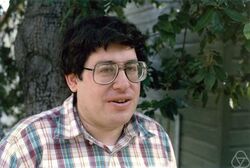Biography:Daniel Goldston
Daniel Goldston | |
|---|---|
 | |
| Born | January 4, 1954 Oakland, California, US |
| Nationality | American |
| Alma mater | University of California, Berkeley |
| Known for | GPY theorem in number theory |
| Awards | Cole Prize (2014) |
| Scientific career | |
| Fields | Mathematics |
| Institutions | San Jose State University |
| Thesis | Large differences between consecutive prime numbers (1981) |
| Doctoral advisor | Russell Lehman |
Daniel Alan Goldston (born January 4, 1954, in Oakland, California) is an American mathematician who specializes in number theory. He is currently a professor of mathematics at San Jose State University.
Early life and education
Daniel Alan Goldston was born on January 4, 1954, in Oakland, California. In 1972, he matriculated to the University of California, Berkeley, where he earned his bachelor's degree and, in 1981, a Ph.D. in mathematics. His doctoral advisor at Berkeley was Russell Sherman Lehman; his dissertation was entitled "Large Differences between Consecutive Prime Numbers".[1]
Career
After earning his doctorate, Goldston worked at the University of Minnesota Duluth and then spent the next academic year (1982–83) at the Institute for Advanced Study (IAS) in Princeton. He has worked at San Jose State University since 1983, save for stints at the IAS (1990), the University of Toronto (1994), and the Mathematical Sciences Research Institute in Berkeley (1999).
Research
In 2009, Goldston, János Pintz, and Cem Yıldırım proved: [math]\displaystyle{ \liminf_{n\to\infty}\frac{p_{n+1}-p_n}{\log p_n}=0 }[/math]
where [math]\displaystyle{ p_n }[/math] denotes the nth prime number. In other words, for every [math]\displaystyle{ c\gt 0\ }[/math], there exist infinitely many pairs of consecutive primes [math]\displaystyle{ p_n\ }[/math] and [math]\displaystyle{ p_{n+1}\ }[/math] which are closer to each other than the average distance between consecutive primes by a factor of [math]\displaystyle{ c\ }[/math], i.e., [math]\displaystyle{ p_{n+1}-p_n\lt c\log p_n\ }[/math].[2] This result was originally reported in 2003 by Goldston and Yıldırım but was later retracted.[3][4] Then Pintz joined the team and they completed the proof with the GPY sieve.
Recognition
In 2014, Goldston won the Cole Prize, shared with Yitang Zhang and colleagues Cem Yildirim and János Pintz, for his contributions to number theory.[1] Also, Goldston was named to the 2021 class of fellows of the American Mathematical Society "for contributions to analytic number theory".[5]
See also
- Landau's problems
- Yitang Zhang
- James Maynard (mathematician)
References
- ↑ 1.0 1.1 "2014 Cole Prize in Number Theory". American Mathematical Society. https://www.ams.org/notices/201404/rnoti-p399.pdf.
- ↑ "Primes in tuples. I". Annals of Mathematics. Second Series 170 (2): 819–862. 2009. doi:10.4007/annals.2009.170.819.
- ↑ "Bounded gaps between primes | American Inst. Of Mathematics". http://aimath.org/primegaps/.
- ↑ "Residueerror". http://www.aimath.org/primegaps/residueerror/.
- ↑ 2021 Class of Fellows of the AMS, American Mathematical Society, https://www.ams.org/cgi-bin/fellows/fellows_by_year.cgi?year=2021, retrieved 2020-11-02
External links
 |

